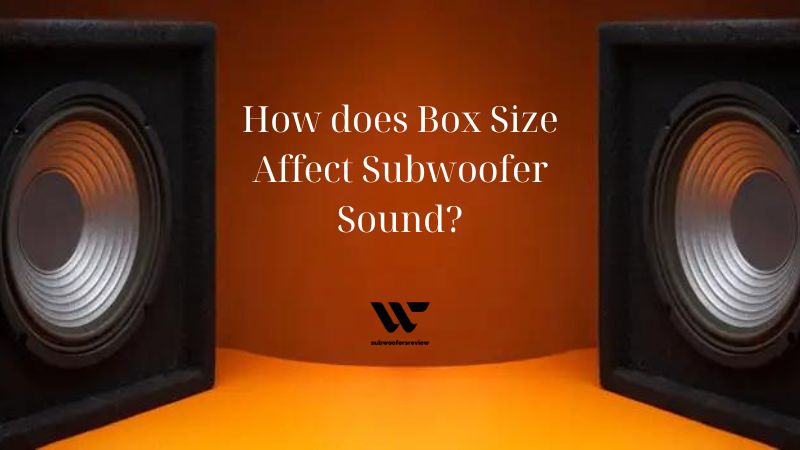When it comes to getting the most out of your subwoofer, there are several factors to consider. One significant element that can greatly impact the sound quality is the size of the box. But just how does box size affect subwoofer sound?
In this blog post, subwoofersreview will explore the relationship between box size and subwoofer performance, delving into the various theories and arguments surrounding this topic. So, if you’re curious to learn more about this intriguing subject, keep reading!
Does Subwoofer Box Size Matter?
The frequency response, output power, and overall audio quality of a subwoofer box are strongly correlated with its size. More bass and better low-frequency output are often found in larger boxes, whereas tighter bass and better sound clarity are typically found in smaller boxes.
Furthermore, the size of the box influences the kind and dimension of subwoofer drivers you can utilize as well as the overall power of your subwoofer system. The bass notes produced by larger subwoofer boxes can be deeper.
Larger drives are usually needed for larger boxes, which normally cost more money and use more power. A smaller driver, which is typically less expensive and consumes less power, will be necessary for a smaller box, on the other hand.
In order to choose the right box size for your subwoofer, it’s crucial to take into account the size of the driver you intend to use as well as the power and sound quality you want to achieve.

How does Box Size Affect Subwoofer Sound?
When it comes to subwoofers, the size of the cabinet has a significant impact on the overall performance and sound quality. The subwoofer’s box size has a direct impact on how well it reproduces low frequency sound waves.
Sealed Enclosures
Typically, a smaller sealed box produces a bass response that is tighter and more controlled. The subwoofer can move precisely and firmly while generating strong and clear bass because of the trapped air inside, which functions as a spring.
The overall efficiency and low frequency scalability may suffer with an increase in sealed box size. Deep bass sounds may be difficult for subwoofers to accurately and with the same impact reproduce.
Ported Enclosures
Since the ports design allows for more effective air circulation, smaller ported enclosures can produce higher low frequency output. Subwoofers can create bass that is louder and clearer, especially when set to a certain frequency range.
A ported enclosure that has been extended past the ideal size may lose control and produce boomy or loose bass. A decrease in output and general efficiency may also result.
The results might not be as good as those obtained with the larger driver if your box only has an 8-inch driver. It’s crucial to select a subwoofer size that satisfies your listening needs as well as the space where it will be positioned.
Larger subwoofers, such as those with 12- or 15-inch drivers, may be more appropriate if you require deep, powerful bass to fill a large room. An 8-inch or 10-inch subwoofer can be more appropriate if you have a small space or require sound reinforcement.
A subwoofer system’s sound quality, bass response, efficiency, and power management are all strongly impacted by the size of the subwoofer box. Regardless of whether it’s a sealed box or a gated box, it’s critical to select the proper box size based on the manufacturer’s recommendations and design principles. You may get a rich and immersive audio experience with the correct box size, which guarantees accurate and powerful bass reproduction.
Which Subwoofer Size Produces the Strongest Bass?
Due to the bigger surface area of the speaker than 12-inch speakers, the 15-inch subwoofer is noted for creating more potent and dramatic bass. Additionally, 15-inch subwoofers can usually take more power without compromising sound quality.
But it’s important to keep in mind that a subwoofer’s performance is not just based on its size. The effectiveness of the subwoofer is also influenced by other factors, including design and materials. To ensure that the subwoofer you choose will satisfy all of your audio needs and tastes, take into account all of these elements.

Which Subwoofer Size Produces the Highest Quality Sound?
A 12 inch subwoofer is suggested since it will provide the highest-quality sound if size, power, space, and price are not your primary concerns when choosing.
The majority of automobile or home audio systems can accommodate a subwoofer this size without difficulty. It produces tremendous bass. A 10- or 8-inch subwoofer might perform better in place of a 12-inch subwoofer, though, if that size isn’t appropriate for your particular arrangement.
In the end, a variety of considerations, including as listening preferences, financial constraints, and the installation location, will determine which subwoofer is appropriate for your needs. You can make sure that the subwoofer provides the desired sound quality and performance by carefully examining these factors and conducting your study in advance.
Final Words
In conclusion, the size of the box has a significant impact on the sound produced by a subwoofer. A larger box size tends to produce deeper and more powerful bass, while a smaller box size results in tighter and more precise bass. It is important to consider the specific requirements and preferences when choosing the appropriate box size for a subwoofer.
Additionally, other factors such as the subwoofer’s design, amplifier power, and room acoustics should also be taken into account for optimal sound performance. Ultimately, finding the right balance between box size and other variables will help achieve the desired sound quality and enhance the overall audio experience.

